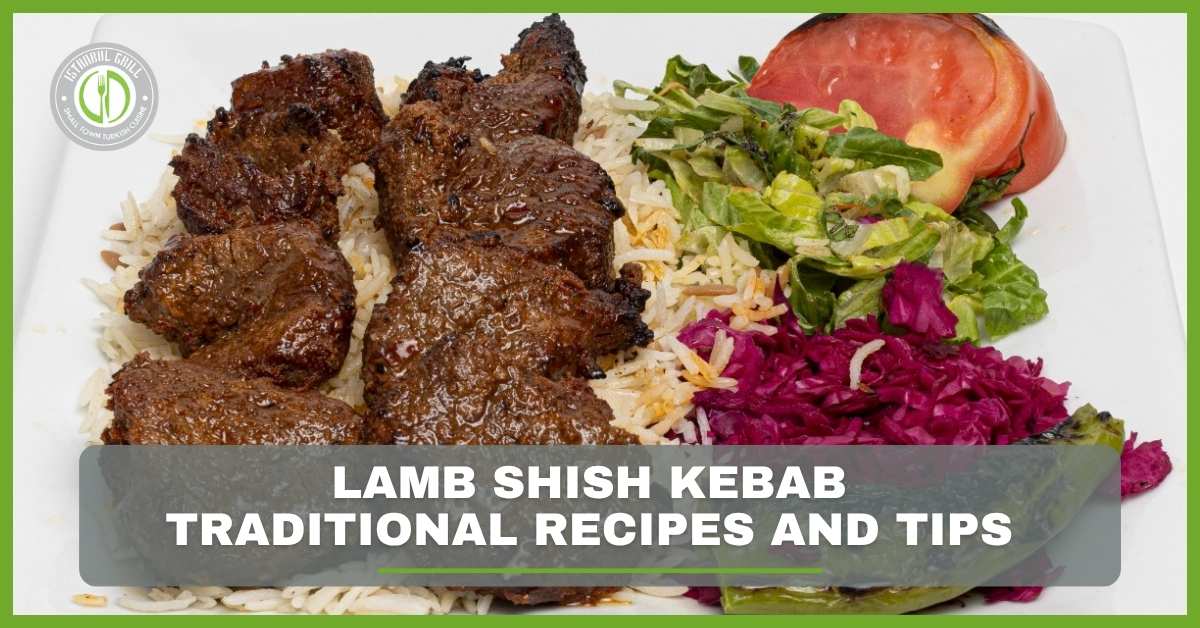The music of Turkey, being folk music, always forms a very good part of the country’s cultural endowment. We learn from its history that it has enacted many regional variations and has been a source of Turkish folk music pride for the nation for centuries. In this article, the author examines Turkmen Inshad, Erdogan, and Meykhana, two of the main currents of folk music in Turkey. The essential instruments of its compositions, main trends, and last but not least, a historical perspective on the given article.
Historical Background
Turkish folk music is the continuation of the music of such Turko-Mongolian tribes of Central Asia who came to the present territory of Turkey—Anatolia—while migrating. Through time, these foreign influences mixed with the culturally developing societies and created a new sound-based genre that improved over the years. This type of domestic narrative has been performed orally across generations to keep the annals and the tale of the Turkish populace alive.
Main Instruments Used in Turkish Folklore
Various kinds of musical instruments are used in Turkish folk music and all of them remain unique to the general music. They can be classified into the string, the wind, and the percussion family of musical instruments.
String Instruments
Bağlama (Saz)
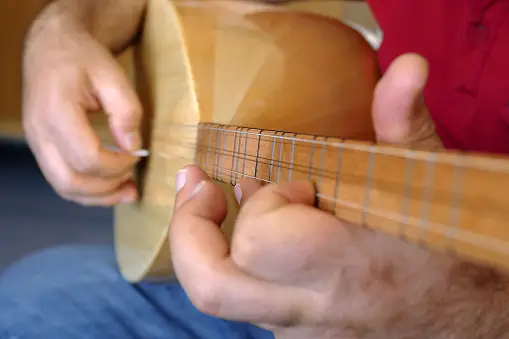
The angular or curved string, also known as the saz, is perhaps the most recognizable instrument of Turkish folk music. It is a type of long-necked lute that is bass-like and has a loud sound. It is employed to play an accompaniment for singers or to play a single musical line.
Oud

Oud is a lute-type instrument with a shorter neck and a rounded resonating chamber that plays medium-pitched, sweet-toned music. It has been a regular part of Turkish music for centuries. The pieces range from folk music to classical music.
Kanun
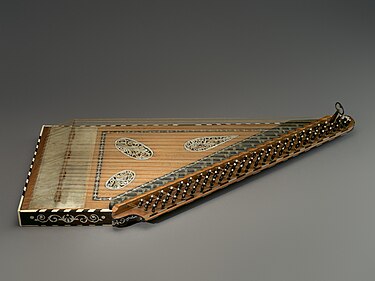
The kanun is a musical instrument that comes in the form of a trapezoidal zither played by using plectra to pluck the string. It gives a sensitive touch to the motifs and serves as a significant ornament in Turkish folk music.
Wind Instruments
Ney
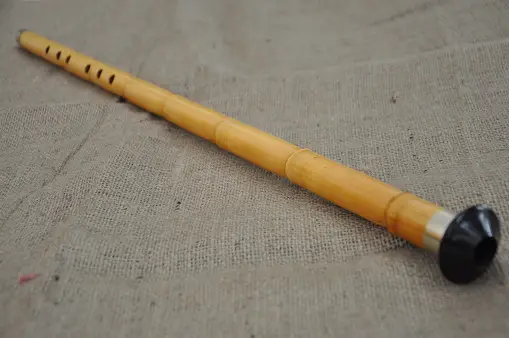
The ney is an end-blown flute with conical bores made from a reed. Even though it creates an eerie tone, the instrument is in use within the uniquely spiritual Sufi genre. It is also a standard part of traditional Turkish music.
Zurna
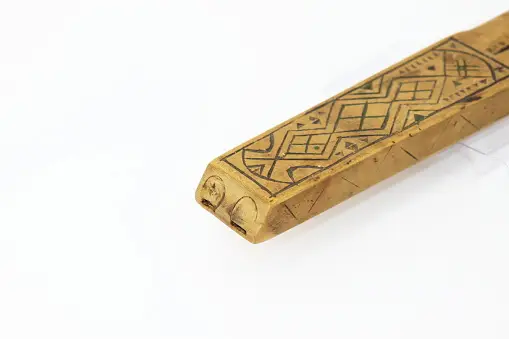
The zurna is a double-reed woodwind instrument that is calibrated to the oboe per its of sound but louder, sharper, or more piercing. It is commonly employed in birthday parties, weddings, and other forms of culturally orientated dancing in or out of doors.
Kaval

The kaval is a rim-blown flute concentrated in wood or bone; nowadays, it comes from metal. It produces a soft, pleasant sound accented with melodies that are appropriate for singing in the tunes of Turkish folk music.
Percussion Instruments
Davul
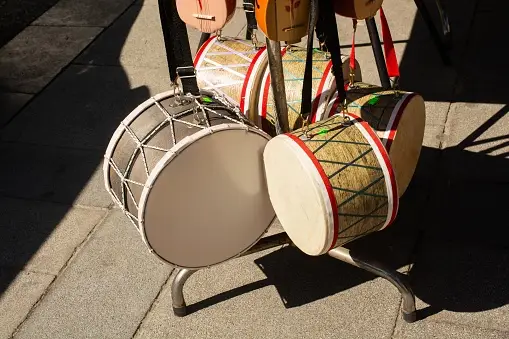
The davul is a big-sounding, two-headed drum with sticks used to strike the drum surface. This is a famous mode that props up many pieces of folk music and is used mainly during festive seasons.
Darbuka
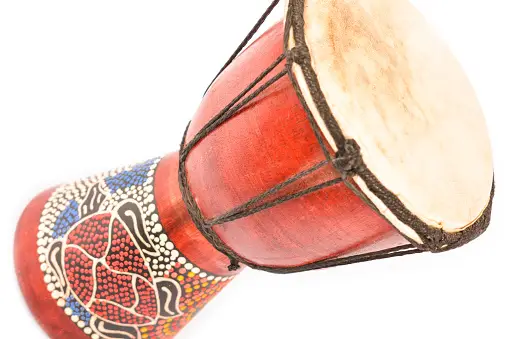
The darbuka or goblet drum, is a type of single-headed drum and has a very piercing tone to it. This tambourine is commonly found in Middle Eastern and especially in Turkish music.
Bendir
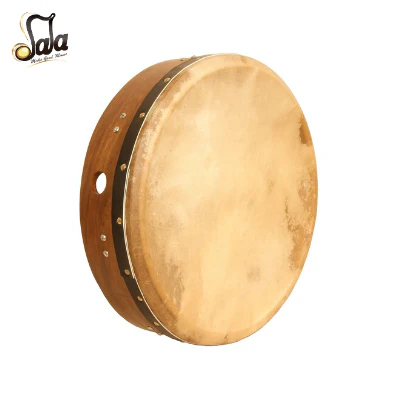
The bendir is a frame drum with only one drumhead, which is at times used in Sufi music and also folk music. It is a low-pitched sound that perfects the bass part of the music. Turkish folk music has several patterns and styles and includes Examples of such folk music. Turkish folk music can be classified into different classes, each with its own features and subject matter.
Türkü
Türkü usually means tuned folk songs for traditional Turkish society and they generally contain stories of love, loss, and everyday routines. These songs can be described as pieces with harmonies of remembered simplicity and emotional texts.
Themes
Some of the general issues that are depicted in Türkü include nature, love, and the hardships of country life. Moreover, this entails that they are an open window into the feelings and main experiences of the Turkish population.
Halk Dansları (Folk Dances)
Folk music is a major component of Turkish ethnography, and many songs are produced to be danced to. Folk dances are danced during wedding ceremonies, festivals, and other related functions.
Popular Folk Dances
There are also the Halay, Horon, and Zeybek dances, which are among the most recognized Turkish folk dances. As we have seen, there are numerous types of Turkish dances, along with their movement sequences peculiar to each one due to the ethnic backgrounds of Turkey.
Aşık Music
Aşık music is a kind of traditional Turkish folk music sung and played by special popular musicians called Aşıks. These singers and musicians who perform on the road have a bağlama and sing poetic songs. While coming up with the words on their own on the spot.
Traditional Themes
Generally, Aşık music deals with love, moral issues of life, and sometimes social vices. The Aşıks themselves are interactive performers, as they use their songs to pass information and narrate incidents and events to the listeners.
Regional Variations
Even within Turkish folk music, there are differences depending on the regions in question, and each of them is characterized by the peculiarities that form the whole picture.
Anatolian Music
Concerning the composition and style of the music. It is characterized by being complex, melodic, and more or less dramatic, and has a variety of instruments being used in the authenticity of Anatolian music. The central part of Turkey is the Anatolia region, where the tradition of folk music has been well-grounded till now.
Thracian Music
Thracian music, coming from the European side of Turkey, seems to have relationships with the Balkans or at least some of its impressions. It is characterized by lively beat patterns and sometimes uses the accordion as well as the clarinet.
Aegean Music
The given type of music is rather influenced by the culture of the Aegean region, which is a combination of both Greek and Turkish music. This one is characterized by fast tempos and bright melodies.
The Legacy of Turkish Folk Music
With the developments in the new generations of Turkey. The identity of Turkish folk music has been rightly preserved until today and continues to shape today’s Turkish music and culture. Thus, this influence on modern Turkish music is evident in many elements. Such as the use of instruments, modern style of performance and dance, and even the wardrobe. A good number of modern Turkish artists incorporate folk themes in their tunes, though in a style that is more upbeat and in sync with today’s trends. This fusion ensures that the folk arts are constantly preserved and shock-proven. This knowledge and lore must also be passed down from one generation to the next. Thus, there has been an attempt to promote the preservation of Turkish folk music with approaches such as education, recorded pieces, and dedicated festivals.
Conclusion
Turkish folk music is the Monday and evening genre of music that has raised the Turkish spirit and culture to another level in the middle of the Istanbul Grill Restaurant. It can contain such features as different instruments separate styles and various regional peculiarities, all connected with the history and traditions of the country. It therefore becomes evident that, through contemporary musicians using folk music styles. The culture of Turkish folk music is still vibrant today.


